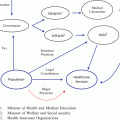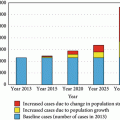Fig. 8.1
Map of Jordan (CIA World Factbook)
The climate of the country is mostly moderate to dry desert; temperature on average ranges from 4 to 31 °C. Natural resources in Jordan include phosphates, potash, and shale oil. Natural freshwater resources are limited [2].
People and Society
The population of Jordan is estimated at 7,930,491 (July 2014). Ninety-eight percent of the population is Arab, while Circassian and Armenian account for the other 2 %; 97.2 % are Muslim, and Christians account for 2.2 % [2].
The population of Jordan age structure is mostly young with the age group of 0–14 years accounting for 35.8 % (2014 estimate). Population growth rate is estimated in 2014 to be 3.86 %, leaving Jordan at the fourth position in comparison to the world (Fig. 8.2).
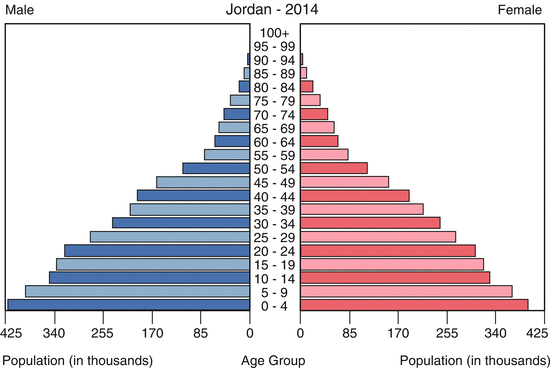

Fig. 8.2
Age structure of Jordanian population of August 2014 (CIA World Factbook)
Health System in Jordan
The country’s health care system is divided between the public and private sectors. The Ministry of Health (MOH) operates 1245 primary health care systems and 31 hospitals accounting for 37 % of all hospital beds in the country [3].
The Royal Medical Services (RMS) runs 12 hospitals providing 24 % of all beds. RMS provides comprehensive insurance for around 25 % of the population [3].
Jordan has two university hospitals, the Jordan University Hospital (JUH) in Amman and the King Abdullah University Hospital (KAUH) in Irbid, both account for 3 % of total beds. The private sector provides 38 % of all hospital beds distributed among 61 hospitals [3].
Refugees in Jordan
Beginning from 2011 the civil war in Syria resulted in large numbers of Syrians to seek refuge in Jordan. Jordan has received the second highest number of Syrian refuges, relative to its population (8 %). According to United Nations High Commissioner for Refugees (UNHCR), 618,515 Syrians reached Jordan as of November 2014, of those 53 % are children [4, 5]. These refugees are distributed at Zaatari camp and Mrajeeb Al Fhood refugee camps (Fig. 8.3). About 70 % of Jordan’s refugees are outside of the refugee camps [4].
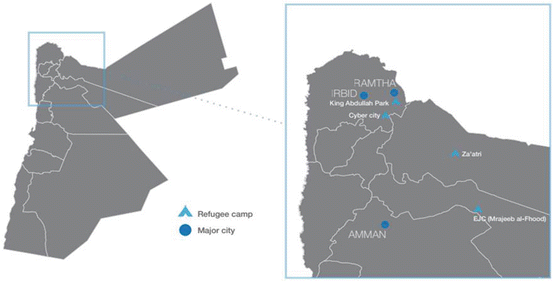

Fig. 8.3
Map of refugees camps in Jordan (UNHCR 2014)
Other Refugees and internally displaced persons to Jordan include 63,037 from Iraq (2012), thus resulting in a net migration rate of 17.22 migrant(s)/1000 populations (2014 estimate), leaving Jordan in the fifth position as compared to the world [1].
Cancer in Jordan
Cancer is the second most common cause of death after cardiovascular diseases in Jordan. Both cancer incidence and prevalence have been increasing in the last decades and cancer patterns are changing quickly in Jordan. The progression of cancer is an important cause of morbidity and mortality in the country; therefore, the MOH became aware of the urgent need to develop appropriate policies to control this increasing problem [6].
In Jordan, cancer burden continues to grow, which is similar to growth trends in low to middle income countries. Additionally, the population in Jordan is growing and aging, yet, has not fully adopted healthy lifestyles that may help prevent many noncommunicable diseases (NCD) including cancer. The incidence and burden of cancer in Jordan are overwhelming especially with the burden of the refugee crisis.
In the 2010 report of the Jordanian Cancer Registry (JCR) [6] on cancer incidence and epidemiology in Jordan, the total number of reported new cancer cases was 6820, of those 4921 were Jordanians (72.2 %) and 1899 were non-Jordanian (27.8 %). In 2010, the number of new cases among Jordanians increased by 123 cases compared to 4798 cases in 2009 [6].
The number of new cancer cases diagnosed among Jordanians has increased by 46% in the past 10 years, from 3362 cases in 2000 to 4921 in 2010. The Crude Incidence Rate (CIR) of all cancers among Jordanians was 79.4 per 100,000 (74 for males and 85.1 for females). The Age Standardized Incidence Rate (ASR) adjusted to the world standard population was 135.1 per 100,000 population (132.8 for males and 138.4 for females). Overall, 32.4 % of new cancer cases in 2010 were diagnosed among people aged 65 and older, who account 3.3 % of Jordanian population [6].
Distribution of new cancer cases by age group showed that 4 % of the cases were below 15 years and 25 % in the age group 15–44 years, and 38.4 % in the age group 45–64 years.
Among Jordanian males, the top five cancer types were colorectal 332 (14.2 %), lung 311 (13.3 %), prostate 218 (9.4 %), urinary bladder 186 (8 %), and leukemia 127 (5.5 %) [6].
Among Jordanian females, the top five cancers were breast 941 (37.4 %), colorectal 226 (9 %), thyroid 136 (5.4 %), non-Hodgkin Lymphoma 130 (5.2 %), and uterine 113 (3.6 %) [6].
Cancer in Children in Jordan
The age structure of Jordanians is mostly of younger age group, where 35.8 % of Jordanians are below the age of 14 years, 56.2 % are below 24 years (median age 21.8 years) (Fig. 8.4).
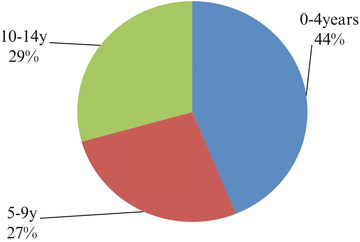

Fig. 8.4
Percentage distribution of pediatric cancer case by age group, 2010—Jordan, Cancer Incidence in Jordan-2010
According to the Jordanian cancer registry of 2010 [6], there were 194 children in the age group 0–14 years diagnosed with a new cancer in Jordan which constitutes 4 % of all registered malignant tumors in the year 2010. The distribution of cases by sex shows that there were 110 cancer cases in males (56.7 %) and 84 cases in females (43.3 %). The male-to-female ratio was 1.3:1 [6].
The CIR for all cancers in this age group was 85 per million (94 per million for boys and 76 per million for girls). Mean age at diagnosis was 6.5 years. About 44 % of registered cases were under the age 5 years [6, 7].
The top five cancer types in the pediatric age group were leukemia 31 %, brain and CNS 26 %, lymphoma 18 %, kidney 10 %, and soft tissue cancers 9 % (Figs. 8.5 and 8.6). The five year survival and ten year survival rates in children are 79.8 % and 76.7 %, respectively. The best survival rates were best seen in Acute Lymphoblastic Leukemia and lymphoma (may reach up to 90 % in certain types) and the worst rates were seen in bone tumors and adrenal tumors (70 %) [7]. The pattern of childhood cancer in Jordan appears similar to other countries in the region but the survival rates are better in Jordan than in other countries in the region [7, 8].
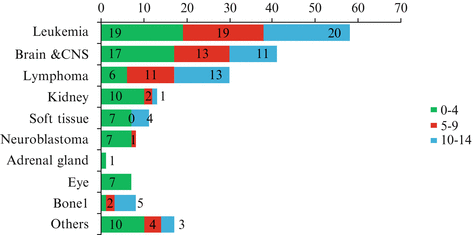
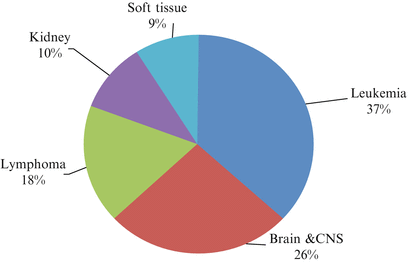

Fig. 8.5
Distribution of childhood cancer by age group and site of tumor, 2010—Jordan, Cancer Incidence in Jordan-2010

Fig. 8.6
Percentage of top five cancers in pediatric age group (both sex), 2010—Jordan, Cancer Incidence in Jordan-2010
Children with cancer receive treatment in pediatric oncology wards in the King Hussein Cancer Center (KHCC) and in the RMS hospital in the capital Amman or in the pediatric departments in KAUH and Princess Rahma Hospital in Irbid with full government coverage [8–10]. Pediatric cancer treatment in Jordan follows the most recent treatment protocols from the USA or the UK, and Europe. Most chemotherapeutic agents are available but may be expensive; radiotherapy is available and modern. Pediatric oncologists are available and well experienced; most are trained in the USA or the UK [10].
Stay updated, free articles. Join our Telegram channel

Full access? Get Clinical Tree



